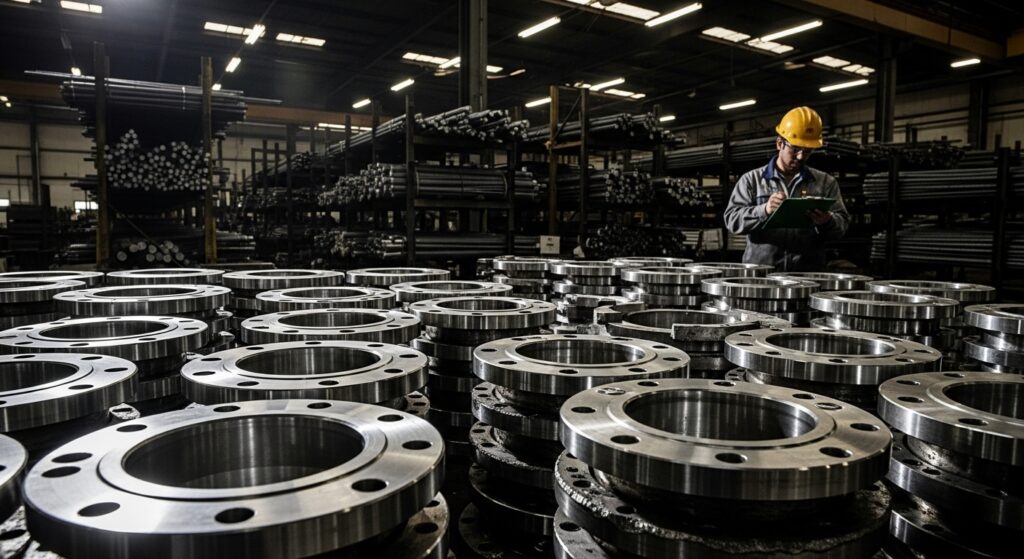If you’re trying to source API flanges right now, you know something’s different. API flange raw material shortage is causing longer lead times and unpredictable prices. The issue starts even before the machining process it begins with the raw materials themselves.
The global shortage of quality steel is creating real challenges for projects that depend on reliable API flange supply. This isn’t just a temporary delay. It’s a fundamental shift in how we plan for critical components.
Let’s talk about what’s causing this shortage, how it affects your projects, and what you can do about it.

What’s Causing the API Flange Material Shortage?
This situation didn’t appear overnight. Several factors created the perfect storm we’re dealing with today.
Global demand for quality steel is higher than current production can support. Major infrastructure projects and industrial growth are consuming available supply faster than mills can produce.
Energy costs and international trade policies have also disrupted production. Some steel-producing regions have faced operational challenges that limit their output.
And you might be thinking, “Will this ever get better?” Most industry experts see these challenges continuing through 2024. The key is adapting to this new reality.
How the Shortage Affects Your API Flange Orders
The material shortage impacts your projects in three specific ways that matter for planning and budgeting.
Longer Lead Times Across the Board
The most immediate effect is extended waiting periods. What used to be an 8-week lead time for standard API flange sizes might now be 16-20 weeks. The delay isn’t just in machining—it’s in waiting for the raw steel to become available.
Unpredictable Pricing
Raw material costs are more volatile than we’ve seen in years. This means the quote you receive today might not be valid in 30 days. It makes long-term project budgeting much more challenging.
Potential Quality Concerns
In a tight market, some suppliers might compromise on material quality. One thing to consider is that proper material certification is more important than ever. You need to be certain the API flange you receive meets the specified chemistry and mechanical properties.
A quick tip: Always request and review Material Test Reports (MTRs) before approving shipments, especially during supply constraints.
Your API Flange Dimensions Haven’t Changed But Availability Has
Here’s an important distinction: the shortage isn’t changing API flange dimensions or standards. The technical specifications in your API flange chart remain exactly the same.
The challenge is finding suppliers who can deliver flanges that meet those specifications without long delays. This is where having a reliable API flange manufacturer becomes critical.
Even with your API flange slide rule showing the correct measurements, you might wait months for the actual components. This disconnect between specification and availability is what frustrates many engineers and project managers.
Strategies for Navigating the Material Shortage
You can’t single-handedly fix global supply chains, but you can make smarter decisions that protect your projects.
Plan Further Ahead Than Ever Before
The days of last-minute ordering are over. You need to integrate extended lead times into your project schedules from the very beginning. If you normally ordered 8 weeks before needing flanges, now plan for 16-20 weeks.
Consolidate Your Orders
Instead of placing multiple small orders, try to combine requirements. Larger orders are more attractive to mills and manufacturers. This can sometimes secure you a better position in the production queue.
Verify Quality Rigorously
Now is not the time to compromise on quality verification. We provide complete material certification with every order because we know how critical this is for safety and performance.
Frequently Asked Questions
How long will the API flange material shortage last?
Most industry analysts expect challenges through 2024 and likely into 2025. The situation improves gradually, but extended lead times are the new normal for now. Planning ahead remains essential.
Are certain API flange sizes more affected than others?
Larger and less common sizes typically face longer delays. Standard API flange sizes in high volume may be more available, but still with extended lead times compared to historical norms.
How can I verify material quality during shortages?
Always request Material Test Reports (MTRs) that trace the material back to its original heat number. Reputable suppliers like Texas Flange provide complete documentation with every order.
Has the shortage affected API flange dimensions?
No, the technical specifications and API flange dimensions remain unchanged. The shortage affects availability and lead times, not the standardized measurements found in API flange charts.
Can I use alternative materials for API flanges?
Material substitution requires careful engineering review. The specified materials ensure proper strength and corrosion resistance. Changing materials without proper analysis can create safety risks.
What’s the best way to get current API flange dimensions?
The official API flange dimensions PDF from API standards is always correct. For quick reference, trusted suppliers maintain accurate API flange dimension charts on their websites.
Getting Your Flanges Despite the Shortage
The raw material shortage is real, but it doesn’t have to stop your projects. It does require changing how you approach procurement and planning.
We’re helping our clients navigate these challenges by providing honest lead times and maintaining our quality standards. Our direct relationships with mills help us secure material when it’s scarce.
Need reliable API flanges in a challenging market? Contact us for current availability and realistic lead times. We’ll give you straight answers and quality components you can depend on.